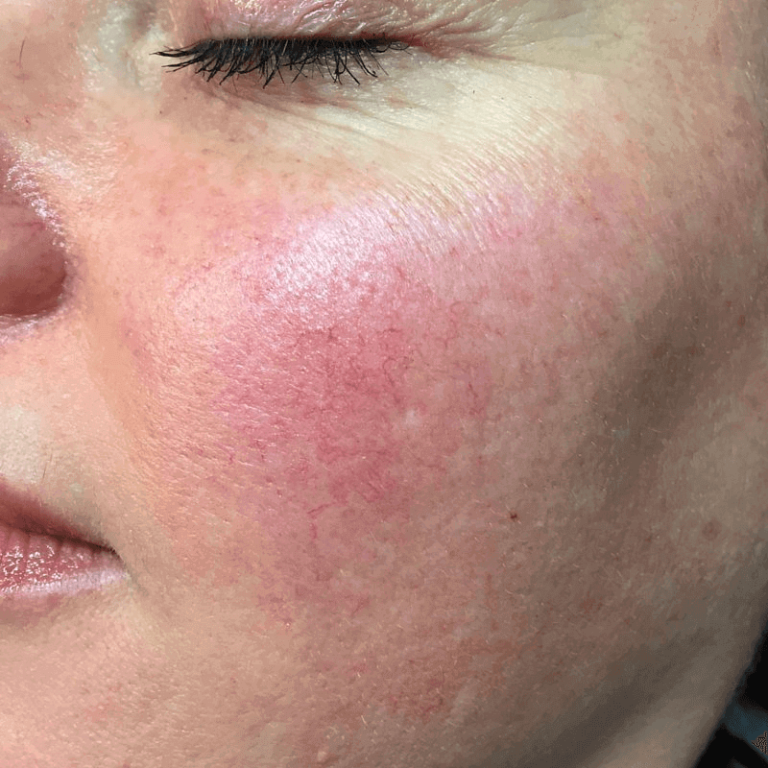How it works:
Share your skin goals and snap selfies
Your dermatology provider prescribes your formula
Apply nightly for happy, healthy skin
How it works:
How it works:
Share your skin goals and snap selfies
Your dermatology provider prescribes your formula
Apply nightly for happy, healthy skin
How it works:
Spider veins on your face: What causes them, and how can you treat them?
Curology experts explain the reasons behind spider veins and ways to treat them.



You look in the mirror and see them for the first time: broken blood vessels on your face. The bad news? You don’t know why they’ve appeared, you don’t know what to do about them, and you definitely don’t want them.
The slightly better news? These veins, called spider veins, are very common, especially in women. They can be caused by various conditions, such as rosacea (most common) or liver disease, but they can also be caused by lifestyle factors. There are plenty of treatment options for spider veins on your face that can reduce or even eliminate them. This article will help you determine the best treatment for you.
What are spider veins, and why do I have spider veins on my face?
Spider veins are small, broken, visible veins that can occur on different areas of the body, including the face—though they’re most commonly found on the legs.¹ They’re a type of varicose vein called a telangiectasia or thread vein.

Facial spider veins are often described as varicose veins on the face, small red veins on the face, or purple veins on the face. They often appear across the cheeks.
Are spider veins dangerous or painful?
Spider veins on the face are harmless and not usually painful; however, they may make you self-conscious. If you find that your spider veins are uncomfortable or painful, you should talk to your medical provider. Otherwise, they’re considered more a cosmetic problem than a medical one.
How common are spider veins?
Spider veins are fairly common, especially in older women. That said, about 20% of adults get varicose veins (including spider veins) in their lifetime. These may include spider veins on the chin, cheeks, or elsewhere on the face.²
Do spider veins on the face go away?
The appearance of spider veins on the face may improve naturally over time, especially if they are caused by a reversible condition, such as weight gain. However, only medical intervention can eliminate spider veins completely.³
What can cause spider veins on the face?
Spider veins on the face can be caused by a number of factors. Here are a few potential reasons:
1. Aging
Spider veins become more common with age.⁴ There’s not a lot you can do to avoid them, but maintaining a healthy weight can help.⁵ You may also find it helpful to see spider veins as a natural and normal part of the aging process.
2. Genetic factors
Spider veins are also linked to genetic factors. If one or both of your parents have spider veins or another type of varicose vein, you’ll be more likely to get them, too.⁶ However, there are still effective treatments available for spider veins that appear due to genetics.
3. Pregnancy
Another common cause of spider veins is pregnancy. Extra blood in the body during pregnancy can cause your veins to swell visibly. If this happens to you, you may find that your spider veins disappear after giving birth.⁷
4. Rosacea
Rosacea is a chronic inflammatory skin condition. It’s more common in females and those with fairer skin. Common symptoms include blushing or redness across your face that comes and goes, and potentially a burning or stinging sensation when using skincare products. Spider veins can also appear with rosacea.⁸

5. Sun damage
Sun exposure can lead to spider veins or broken veins in your face and neck due to the UV rays damaging the superficial blood vessels in your skin. The easiest way to help prevent this from happening is to minimize your sun exposure and use a broad spectrum SPF 30+ sunscreen every day.
6. Violent sneezing or vomiting
If you sneeze violently or vomit, this can cause sudden, high pressure in your face—meaning a sneezing fit can cause little blood vessels in your skin to break, leaving you with spider veins. If you find that your violent sneezing is triggered by pollen, dogs, cats, mold, or another specific cause, you may have allergic rhinitis that can be treated with antihistamines.
How can you get rid of spider veins on your face?
Facial spider vein removal might sound daunting, but there are a number of ways to help get rid of spider veins on the cheeks, nose, and chin.
Unfortunately, no topical treatment will make these permanently go away. If they are bothersome to you, you can discuss treatment options with an in-person medical provider. Certain procedures such as laser treatment can help.
Sclerotherapy
Sclerotherapy is a minimally invasive treatment option. It helps remove spider veins by injecting a medication into each vein. This causes the blood vessel to collapse and the blood to clot. As a result, the vessel will gradually turn into scar tissue and then fade away.⁹
Laser therapy
Certain laser therapies can target spider veins by sealing off blood vessels, causing your spider veins to reduce in appearance or even dissolve. It’s often considered less effective than sclerotherapy, however.¹⁰
Start improving your skin today
Get your personalized skincare routine with Curology
Get your personalized skincare routine with Curology


We don’t treat spider veins at Curology, but we can help with other skin conditions, like acne, rosacea, and signs of aging. If you want to start improving your skin’s appearance, speak with a dermatology provider from Curology. Sign up for a 30-day Curology trial* today!
FAQs
Yes, you can improve the appearance of (or potentially get rid of!) spider veins on your face using methods such as sclerotherapy and laser therapy.
Spider veins on the face are very normal, especially as you age. It’s estimated that 20% of adults develop spider veins at some point in their lives.¹¹
Spider veins are usually a cosmetic concern rather than a health concern. If your spider veins are painful, however, you should talk to your medical provider.
P.S. We did the homework so you don’t have to:
1. WebMD. Varicose Veins and Spider Veins: Symptoms and Treatment. (2022, April 26).
2. InformedHealth.org. National Library of Medicine. Varicose veins: Overview. (2019, September 25).
3. Center for Vein Restoration. Can I Get Rid of Spider Veins By Losing Weight? (2021, November 19).
4. InformedHealth.org. National Library of Medicine. Varicose veins: Overview. Ibid.
5. Vein, Heart and Vascular Institute. Here’s How You Can Prevent Spider Veins. (n.d.).
6. Madan, V. Are My Varicose Veins and Spider Veins Genetic? Center for Varicose Veins. (n.d.).
7. Taylor, M. What to Know About Spider Veins During Pregnancy. Grow by WebMD. (2022, August 20).
8. Gallo, R.L., et al. Standard classification and pathophysiology of rosacea: The 2017 update by the National Rosacea Society Expert Committee. Journal of the American Academy of Dermatology. (January 2018).
9. Mayo Clinic. Sclerotherapy. (2023, February 3).
10. Gendler Dermatology. Laser Treatment of Telangiectasias. (n.d.).
11. InformedHealth.org. National Library of Medicine. Varicose veins: Overview. Ibid. Melissa Hunter is a board certified family nurse practitioner at Curology. She received her MSN from George Washington University in Washington, DC.
*Cancel anytime. Subject to consultation. Results may vary.

Curology Team

Melissa Hunter, NP-C